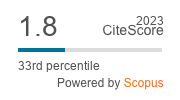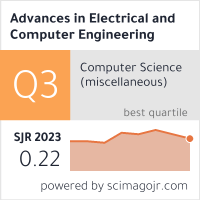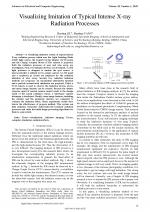| 1/2020 - 3 |
Visualizing Imitation of Typical Intense X-ray Radiation ProcessesLIU, H. |
| View the paper record and citations in |
| Click to see author's profile in |
| Download PDF |
Author keywords
visualization, radiation imaging, X-rays, computer simulation, radiation effects
References keywords
pinch(6), image(6), array(6), radiation(5), plasma(5), nucl(5), imaging(5), sensors(4), pinches(4)
Blue keywords are present in both the references section and the paper title.
About this article
Date of Publication: 2020-02-28
Volume 20, Issue 1, Year 2020, On page(s): 19 - 26
ISSN: 1582-7445, e-ISSN: 1844-7600
Digital Object Identifier: 10.4316/AECE.2020.01003
Web of Science Accession Number: 000518392600003
SCOPUS ID: 85083719664
Abstract
A visualizing imitation system of typical intense X-ray radiation process which uses the Light Emitting Diode (LED) light source, the Liquid Crystal Display (LCD) panel, and the Charge Coupled Device (CCD) camera is proposed. Both the radiation processes of spot and wire array are investigated. First, two imitation devices are developed. A LED light producer is designed to imitate the spot source. A microcontroller is utilized for its output control. A LCD panel and a raspberry pi circuit are employed for the radiation imitation of wire array. Second, two radiation imitation methods are proposed. An exponential attenuation function and a particle system-based simulation are proposed. Third, a CCD camera is used to observe the imitation devices above, and many image datasets can be created. Because the shutter response speed of normal camera cannot reach to the change speed of the actual radiation source, a time-lapse capture technique is developed. Finally, some image features, including the statistic and the geometric metrics, are computed to evaluate the imitation effect. Many experiment results have shown the effectiveness of propose method. This system can help radiation researcher understand the transient radiation processes and study the initial image processing algorithms for them to some extent. |
| References | | | Cited By «-- Click to see who has cited this paper |
| [1] G. L. Morgan, R. R. Berggren, P. A. Bradley, F. H. Cverna, J. R. Faulkner, P. L. Gobby, J. A. Oertel, F. J. Swenson, J. A. Tegtmeier, R. B. Walton, M. D. Wilke, D. C. Wilson, L. Disdier, "Development of a neutron imaging diagnostic for inertial confinement fusion experiments," Rev. Sci. Instrum., vol. 72, no. 1, pp. 865-868, Jan. 2001. [CrossRef] [Web of Science Times Cited 33] [SCOPUS Times Cited 38] [2] C. P. Salomon, C. Ferreira, G. Lambert-Torres, C. E. Teixeira, L. E. B. D. Silva, W. C. Santana, E. L. Bonaldi, L. E. D. L. D. Oliveira, "Electrical signature analysis for condition monitoring of permanent magnet synchronous machine," Adv. Electr. Comput. En., vol. 18, no. 4, pp. 91-98, Nov. 2018. [CrossRef] [Full Text] [Web of Science Times Cited 4] [SCOPUS Times Cited 6] [3] X. Yu , J. Shen , M. Qu , W. Liu , H. Zhong , H. Zhang, S. Yan, G. Zhang, X. Le, "Infrared imaging diagnostics for intense pulsed electron beam," Rev. Sci. Instrum., vol. 86, no. 8, pp. 083305-1-083305-7, Jul. 2015. [CrossRef] [Web of Science Times Cited 13] [SCOPUS Times Cited 13] [4] Y. Xue, Z. Wang, B. He, Z. Yao, M. Liu, W. Ma, J. Sheng, G. Dong, J. Jin, "Theoretical and experimental study of the dark signal in CMOS image sensors affected by neutron from a nuclear reactor," AIP Adv., vol. 7, no. 12, pp. 125222-1-125222-9, Dec. 2017. [CrossRef] [Web of Science Times Cited 4] [SCOPUS Times Cited 4] [5] Y. Sato, Y. Tanifuji, Y. Terasaka, H. Usami, M. Kaburagi, K. Kawabata, W. Utsugi, H. Kikuchi, S. Takahira, T. Torii, "Radiation imaging using a compact Compton camera inside the Fukushima Daiichi nuclear power station building," J. Nucl. Sci. Technol., vol. 55, no. 9, pp. 1-6, May 2018. [CrossRef] [Web of Science Times Cited 36] [SCOPUS Times Cited 41] [6] V. Goiffon, M. Estribeau, P. Cervantes, R. Molina, M. Gaillardin, P. Magnan, "Influence of transfer gate design and bias on the radiation hardness of pinned photodiode CMOS image sensors," IEEE Trans. Nucl. Sci., vol. 61, no. 6, pp. 3290-3301, Dec. 2014. [CrossRef] [Web of Science Times Cited 39] [SCOPUS Times Cited 41] [7] B. Jones, C. Deeney, C. A. Coverdale, C. J. Meyer, and P. D. LePell, "Monochromatic X-ray self-emission imaging of imploding wire array Z-pinches on the Z accelerator," IEEE Trans. Plasma Sci., vol. 34, no. 2, pp. 213-222, Apr. 2006. [CrossRef] [Web of Science Times Cited 14] [SCOPUS Times Cited 17] [8] A. D. Blas, J. Toral, C. Tapia, "Equipment for the continuous measurement and identification of Gamma radioactivity on aerosols," IEEE Trans. Nucl. Sci., vol. 63, no. 3, pp. 1526-1530, Jun. 2016. [CrossRef] [Web of Science Times Cited 1] [SCOPUS Times Cited 1] [9] R. M. Cibils, "Sensitivity enhancement in radiation portal monitoring using adaptive matched filtering," IEEE Trans. Nucl. Sci., vol. 63, no. 2, pp. 1162-1168, Apr. 2016. [CrossRef] [Web of Science Times Cited 2] [SCOPUS Times Cited 2] [10] G. Bellotti, A. D. Butt, M. Carminati, C. Fiorini, L. Bombelli, G. Borghi, C. Piemonte, N. Zorzi, and A. Balerna, "ARDESIA detection module: a four-channel array of SDDs for Mcps X-Ray spectroscopy in synchrotron radiation applications," IEEE Trans. Nucl. Sci., vol. 65, no. 7, pp.1355-1364, Jul. 2018. [CrossRef] [Web of Science Times Cited 18] [SCOPUS Times Cited 21] [11] S. V. Lebedev, R. Aliaga-Rossel, S. N. Bland, J. P. Chittenden, A. E. Dangor, M. G. Haines, and I. H. Mitchell, "The dynamics of wire array Z-pinch implosions," Phys. Plasmas, vol. 6, no. 5, pp. 2016-2022, Nov. 1998. [CrossRef] [Web of Science Times Cited 114] [SCOPUS Times Cited 123] [12] S. V. Lebedev, F. N. Beg, S. N. Bland, J. P. Chittenden, A. E. Dangor, M. G. Haines, K. H. Kwek, S. A. Pikuz, T. A. Shelkovenko, "Effect of discrete wires on the implosion dynamics of wire arrays Z pinches," Phys. Plasmas, vol. 8, no. 8, pp. 3734-3747, Apr. 2001. [CrossRef] [Web of Science Times Cited 309] [SCOPUS Times Cited 325] [13] J. P. Chittenden, S. V. Lebedev, S. N. Bland, F. N. Beg, M .G. Haines, "One-, two- and three-dimensional modeling of the different phases of wire array Z-pinch evolution," Phys. Plasmas, vol. 8, no. 5, pp. 2305-2314, Dec. 2000. [CrossRef] [Web of Science Times Cited 62] [SCOPUS Times Cited 76] [14] D. B. Sinars, "Advances in compact wire-array Z-pinch X-ray sources and Z-pinch diagnostics," In Proc. IEEE Int. Conf. Plasma Sci, Traverse City, MI, USA, 4-8 Jun. 2006, pp. 474. [CrossRef] [15] M. Rezaei, and P. Franti, "Real-time clustering of large Geo-referenced data for visualizing on map," Adv. Electr. Comput. En., vol. 18, no. 4, pp. 63-74, Nov. 2018. [CrossRef] [Full Text] [Web of Science Times Cited 3] [SCOPUS Times Cited 5] [16] F. Zhang, and H. Niu, "A 75-ps gated CMOS image sensor with low parasitic light sensitivity," Sensors, vol. 16, no. 7, pp. 999-1-999-10, Jun. 2016. [CrossRef] [Web of Science Times Cited 5] [SCOPUS Times Cited 5] [17] R. Zhang, C. Mao, K. Huang, X. Zou, and X. Wang, "Comparison of nonuniform transmission lines with Gaussian and exponential impedance profiles for Z-pinch," IEEE Trans. Plasma Sci., vol. 40, no. 12, pp. 3395-3398, Dec. 2012. [CrossRef] [Web of Science Times Cited 16] [SCOPUS Times Cited 23] [18] G. F. Knoll, Radiation Detection and Measurement. Wiley & Sons, New York, pp. 103-119, 1988. [19] W. T. Reeves, "Particle systems - a technique for modeling a class of fuzzy objects," Comput. Graph., vol. 17, no. 3, pp. 359-375, Jan. 1983. [CrossRef] [Web of Science Times Cited 366] [SCOPUS Times Cited 483] [20] R. Bridson, J. Hourihan, and M. Nordenstam, "Curl-noise for procedural fluid flow," ACM Trans. Graph., vol. 26, no. 99, pp. 46-1-46-3, Jul. 2007. [CrossRef] [21] W. Dong, X. Zhang, and C. Zhang, "Generation of cloud image based on Perlin noise," In Proc. IEEE Int. Conf. Multimedia Communications, Hong Kong, China, 2010, pp. 61-63. [CrossRef] [SCOPUS Times Cited 10] [22] J. H. Xue, D. M. Titterington, "t-tests, F-tests and Otsu's methods for image thresholding," IEEE Trans. Image Process., vol. 20, no. 8, pp. 2392-2396, Aug. 2011. [CrossRef] [Web of Science Times Cited 74] [SCOPUS Times Cited 87] [23] H. Liu, F. Li, H. Lu, "Imaging air quality evaluation using definition metrics and detrended fluctuation analysis," In Proc. IEEE Int. Conf. Signal Process., Beijing, China, 2010, pp. 968-971. [CrossRef] [SCOPUS Times Cited 8] [24] X. Zhang, J. Cui, W. Wang, C. Lin, "A study for texture feature extraction of high-resolution satellite images based on a direction measure and gray level co-occurrence matrix fusion algorithm," Sensors, vol. 17, no. 7, pp. 1474-1-1474-15, Jun. 2017. [CrossRef] [Web of Science Times Cited 79] [SCOPUS Times Cited 168] [25] T. Zhao, X. Zou, X. Wang, Y. Zhao, Y. Du, R. Zhang, and R. Liu, "X-ray backlighting of developments of X-pinches and wire-array z-pinches using an X-pinch," IEEE Trans. Plasma Sci., vol. 38, no. 4, pp. 646-651, Apr. 2010. [CrossRef] [Web of Science Times Cited 23] [SCOPUS Times Cited 30] Web of Science® Citations for all references: 1,215 TCR SCOPUS® Citations for all references: 1,527 TCR Web of Science® Average Citations per reference: 47 ACR SCOPUS® Average Citations per reference: 59 ACR TCR = Total Citations for References / ACR = Average Citations per Reference We introduced in 2010 - for the first time in scientific publishing, the term "References Weight", as a quantitative indication of the quality ... Read more Citations for references updated on 2024-07-19 01:50 in 163 seconds. Note1: Web of Science® is a registered trademark of Clarivate Analytics. Note2: SCOPUS® is a registered trademark of Elsevier B.V. Disclaimer: All queries to the respective databases were made by using the DOI record of every reference (where available). Due to technical problems beyond our control, the information is not always accurate. Please use the CrossRef link to visit the respective publisher site. |
Faculty of Electrical Engineering and Computer Science
Stefan cel Mare University of Suceava, Romania
All rights reserved: Advances in Electrical and Computer Engineering is a registered trademark of the Stefan cel Mare University of Suceava. No part of this publication may be reproduced, stored in a retrieval system, photocopied, recorded or archived, without the written permission from the Editor. When authors submit their papers for publication, they agree that the copyright for their article be transferred to the Faculty of Electrical Engineering and Computer Science, Stefan cel Mare University of Suceava, Romania, if and only if the articles are accepted for publication. The copyright covers the exclusive rights to reproduce and distribute the article, including reprints and translations.
Permission for other use: The copyright owner's consent does not extend to copying for general distribution, for promotion, for creating new works, or for resale. Specific written permission must be obtained from the Editor for such copying. Direct linking to files hosted on this website is strictly prohibited.
Disclaimer: Whilst every effort is made by the publishers and editorial board to see that no inaccurate or misleading data, opinions or statements appear in this journal, they wish to make it clear that all information and opinions formulated in the articles, as well as linguistic accuracy, are the sole responsibility of the author.





